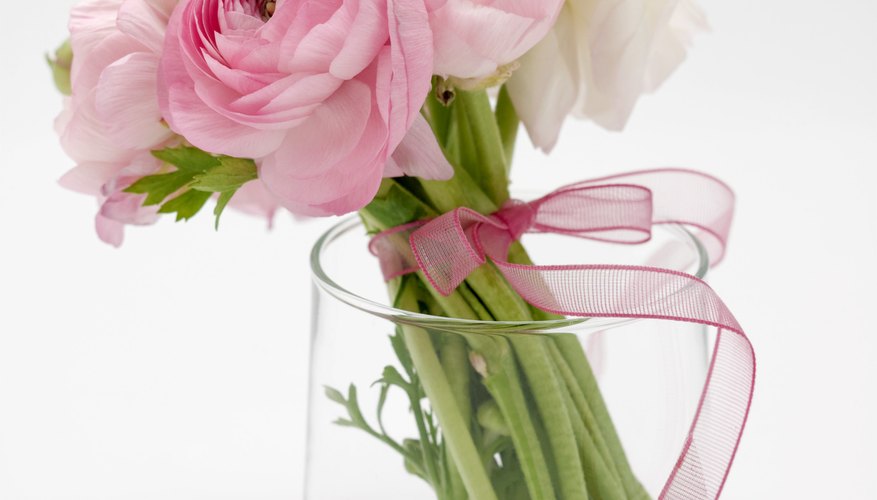Silk flowers are a very popular method of home decorating. They look stylish and realistic, and are a cost-effective substitute for out of season natural flowers. Commercially available “fake water” or florist’s gel is an epoxy resin, a polymer that belongs to the phenol chemical group. This gel sets in a container giving the appearance of clear water and holds the silk flowers in position.
Choose the vase for your floral arrangement. Pour cold water into the vase up to the level at which you would like to fill it with the gel. Use one of the measuring cylinders to measure out that volume of water. Dry the vase and the measuring cylinder.
- Silk flowers are a very popular method of home decorating.
- Pour cold water into the vase up to the level at which you would like to fill it with the gel.
Fill the vase half-way either with the clean sand or the polystyrene balls. Insert the silk flowers to make the kind of arrangement you like. Note down or draw a simple diagram of the flower positions in the vase.
Remove the flowers from the vase. Use a damp cloth to clean the stems. Pour out the polystyrene balls or sand. Wash the vase thoroughly in soapy water. Ensure that it is completely grease and dust free. Leave the vase and flowers in a clean place to dry.
- Fill the vase half-way either with the clean sand or the polystyrene balls.
- Leave the vase and flowers in a clean place to dry.
Ensure that the temperature of the room where you will mix the gel is between 18 and 25 degrees Celsius (59 to 77 degrees Fahrenheit). Check that the epoxy resin and hardener temperatures are within this range. Use the hygrometer to check the humidity is below 70 percent. The gel becomes sticky if the atmosphere is too humid. If you have no access to a hygrometer, leave this job for a dry, warm day. A garage or garden shed is the best place for the job. Don’t do this in the kitchen as general cooking and washing activities may make the atmosphere there too humid.
- Ensure that the temperature of the room where you will mix the gel is between 18 and 25 degrees Celsius (59 to 77 degrees Fahrenheit).
- The gel becomes sticky if the atmosphere is too humid.
Cover the working surface with the newspaper. Use the masking tape to attach the paper firmly to the surface. The mixing procedure may be messy for a beginner and the newspaper protects the work surface from spills. Put on the protective gloves and eye glasses.
- Cover the working surface with the newspaper.
- Use the masking tape to attach the paper firmly to the surface.
Use the measuring cylinders to measure accurately equal volumes of resin and hardener so that their combined volume equals the volume of gel you plan for the vase. As an example, this could be 100 millilitres of resin and 100 ml of hardener. Pour the hardener first into the mixing bowl. Add the resin gently to the hardener. Stir the mixture until all streaks and cloudiness in the mixture have disappeared. Transfer the mixture to the vase and continue stirring. Continue mixing until the gel is completely clear and no air bubbles are trapped.
Insert the silk flowers into the gel according to your planned arrangement. Wire the flowers together so that they stay in place and do not flop over the sides of the vase as the mixture cures. Leave the vase and flowers to stand in place at the temperature range in step 4 for 24 to 48 hours. After 48 hours, the gel should have set firmly. Remove the wires leaving the floral arrangement in position.
TIP
Avoid mixing more than one litre of gel at a time. The reaction of epoxy resin and hardener is exothermic, meaning that it generates heat. This could discolour the cured gel.
Store unused resin and hardener in a safe place away from children and pets.
Use plenty of water to rinse any gel that comes into contact with the skin or eyes.
Seek medical advice immediately of the irritation does not halt with the first rinse.
Use turpentine to remove any gel that may have dripped on the floor or other surfaces.
Don’t try to create your own epoxy resin mixture at home from its original components of formaldehyde, urea, and sulphuric acid. This is a job only for professional chemists in a research laboratory fume cupboard.
Use a one-step gel kit like Craft Water ® if you would like a simpler gel-making procedure.
Keep the floral arrangement in a place where the temperature remains reasonably constant in the recommended range.
WARNING
Avoid breathing any fumes from the gel.
